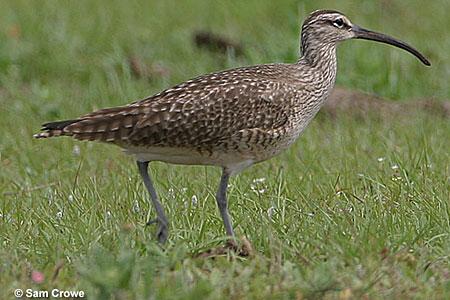With its large size and downcurved bill, some might briefly mistake the Whimbrel for a Long-billed Curlew, although the Whimbrel’s bill is much shorter and it has a distinctly striped head. While not really colonial nesters, Whimbrels do tend to nest in loose groups.
Whimbrels frequently return to the same breeding area in subsequent years, although this trend is stronger following successful nesting seasons. Whimbrels are potentially long-lived, with the oldest known bird in the wild being over 19 years old.
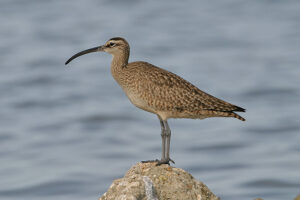
Description of the Whimbrel
BREEDING MALE
The Whimbrel is a long-legged shorebird with a long, decurved bill, dark stripes on the crown and a dark line through each eye, streaked underparts, and mottled brown and white upperparts. Length: 18 in. Wingspan: 32 in.
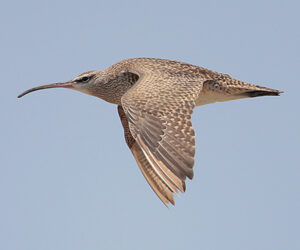
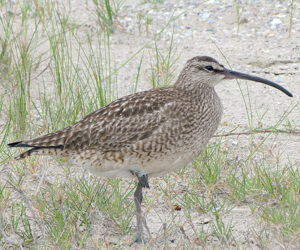
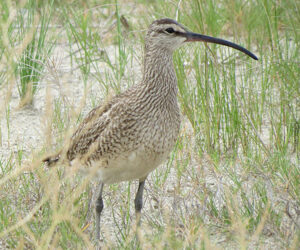
Female
Sexes similar.
Seasonal change in appearance
Minimum.
Juvenile
Juveniles resemble adults.
Habitat
Tundra, marshes, and mudflats.
Diet
Insects and crustaceans, as well as berries.
Behavior
Forages by walking and surface feeding, or by probing.
Range
Breeds in parts of Alaska, Canada, and Greenland, and winters along the coasts of the U.S., Mexico, and Central America. Also occurs in South America, Europe, and Australia.
Wing Shape
The shape of a bird’s wing is often an indication of its habits and behavior. Fast flying birds have long, pointed wings. Soaring birds have long, broad wings. Different songbirds will have a slightly different wing shape. Some species look so much alike (Empidonax flycatchers) that scientists sometimes use the length of specific feathers to confirm a species’ identification.
Wing images from the University of Puget Sound, Slater Museum of Natural History
Fun Facts
Aerial pursuit of one male by another is common during the early breeding season.
Winter foraging territories are sometimes defended.
Vocalizations
The call is a series of whistles.
Similar Species
- Long-billed Curlew
Long-billed Curlews have longer bills and lack dark crown stripes.
Nesting
The nest is a plant-lined depression on the ground.
Number: 4.
Color: Olive of buff with darker markings.
Incubation and fledging:
– Young hatch at 24-28 days. ?
– Young fledge (leave the nest) shortly after hatching but remain with the adults for some time.
Bent Life History of the Whimbrel
Published by the Smithsonian Institution between the 1920s and the 1950s, the Bent life history series of monographs provide an often colorful description of the birds of North America. Arthur Cleveland Bent was the lead author for the series. The Bent series is a great resource and often includes quotes from early American Ornithologists, including Audubon, Townsend, Wilson, Sutton and many others.
Bent Life History for the Whimbrel – the common name and sub-species reflect the nomenclature in use at the time the description was written.
NUMENIIJS PHAEOPUS PHAEOPUS (Linnaeug)
Contributed by Francis Charles Robert FourdainHABITS
The latest and best authority on the birds of Greenland, E. Lehn Schioler, writes that in all probability the whimbrel breeds on the southern part of the west coast of Greenland, perhaps generally in the south, but more especially in the southwest. The only other Anierican record of this species is one from south of Sable Island, Nova Scotia, on May 25, 1906.
Spring: The whimbrel arrives on the British coasts from about mid-April to June 12, but is very frequently noted during the first days of May, from which it derives one of its local names, the “May bird.” On. migration it prefers to haunt the low-lying coast and the adjacent country, feeding on the mud flats and marshes. When on the wing they fly at a great height, but can be recognized by their clear seven-syllabled whistle, tetty, tetty, tetty, tet.
Courtship: Practically nothing is recorded in the standard works on British ornithology on the courtship of this species, but some observations have been made both in Iceland and on the Shetlands. Reimschneider writes that in Iceland one hears its notes all through the long summer day and far into the night, a very long-drawn ku’iu, uttered with inflated throat and scarcely opened bill. The nuptial song of the male is a long-drawn fluty trill, much slower and longer than the alarm note. The bird hardly rises above the ground, but flies with half opened bill for short distances, trilling, then makes quick and short wing strokes and slowly descends to earth again with extended wings, when the cry is again uttered. Bernard Hantzsch (1905) gives a fuller description, which, however, varies in some details. The male is perched on some hillock, from which with wide-opened bill he utters a rolling di-di-di. Now he is off, with his long feet trailing behind and head and neck outstretched. With short and very rapid wing strokes he rises high in the clear sky till almost out of sight, meanwhile uttering his soft fiuty dudu-du, sometimes for minutes together. Then follows a slightly higher and quicker series of notes, ending with a beautiful, soft trill, louder and faster than that of the golden plover. lie then descends spirally toward the nesting place, thence again starting on his u~ward flight. The female also trills, but the song flight is peculiar to the male.
Nesting: The breeding grounds of the whimbrel are the vast expanses of moorland, overgrown with heather and mosses, which are characteristic of the Arctic tundra. The actual nest is a well-defined hollow among the heather or rough grass, scantily lined with a few bits of ling or dry grass and moss. Some nests contain hardly any material and. are merely pressed down and hollowed by the bird. They do not nest as a rule close together and the breeding place is jealously guarded by the male who rises fearlessly to attack and drive off almost any bird which approaches within a 100 yards of the eggs. Even skuas are attacked in this way, but where they are numerous the whimbrel stands but a poor chance of rearing young. In the Shetlands the eggs are laid in the last days of May and early in June, while in Iceland the normal time is at the beginning of June and exceptionally late in May.
Eggs: These are normally four in number, exceptionally three only, especially in late layings, and Hantzsch (1905) records one clutch of five. They are pyriform, and large for the size of the birds, with thin shells. The ground color varies as a rule from pale olive green to pale brownish buff, blotched and spotted with olive brown or reddish brown and with ashy grey shell markings. In some varieties the ground is a beautiful clear green and the blotches very bold and conspicuous, while another scarce type has a bluish grey ground with only large brownish ash blotches. The measurements of 100 eggs, by Doctor Roy and the writer, average 58.9 by 41.2 millimeters; the eggs showing the four extremes measure 65.1 by 41.7, 57 by 44, 52 by 41.6 and 55.3 by 36 millimeters.
Young: Both sexes have incubation patches and from Chislett’s (1923) observations, confirmed also by Hantzsch, both share in the work. The only note we have as to the length of the period is that of Hantzsch (1905) who gives it as three to three and one-half weeks. In the case of a nest watcbed by Chislett the first two young hatched were led away by one bird while the other continued to incubate. This was on June 23 and the following day was cold with a high wind. The third chick wandered from the nest and was sometimes brooded by the incubating bird, which left the fourth egg for that purpose, but she never seemed thoroughly at ease except when covering both egg and chick. By the following morning the last chick had hatched out. Only one brood is reared in the season.
Plumages: The plumages and molts are fully described in A Practical Handbook of British Birds edited by H. S. Witherby (1920).
Food: This species feeds largely on earthworms, and also during the winter months on sandworms (Arenicola). Insects are also freely taken, chiefly beetles (Coleoptera), but also Orthoptera, especially earwigs (Forficula) and crickets (A~heta), larvae of flies (Diptera) etc. During the breeding season many small land mollusca are eaten, especially snails (Helix ericetorum), slugs (Limaa~ agrestris), etc., and in the autumn, marine mollusca, both univalves and bivalves. Small crustacca, including small crabs, shrimps (Crangon) and Gammaridac are also freely taken and the berries of moorland plants such as Empetrum nigrum (crowberry) and Yaciniurn myrtillus.
Behavior: The boldness of this species in defending its nest has already been referred to. It has been frequently seen to attack and drive oft birds much larger and more powerful than itself, such as the raven and the larger gulls. During the winter months it appears to be less of a shore feeder than the curlew, frequently visiting the inland marshes in preference to the mud flats and shores. Chislett (1923) describes its gait as quite different to that of the curlew, its progress being much more rapid and direct. Instead of approaching the nest in a leisurely way with many detours and pauses, it walks with rapid, jerky strides, almost directly to its objective.
Enemies: The large gulls and skuas, though often successfully driven off when approaching singly, are often successful in destroying the eggs or young where present in numbers and the enormous increase in the numbers of the great skua in the Shetlands has proved very detrimental to this species. In Iceland the Arctic fox is also an enemy to be counted with and the crow tribe (raven and hooded crow) are always ready to take advantage of any chance opportunity.
Fall: The young are fledged according to Hantzsch (1905) within a month of hatching and about the beginning of August begin to collect into flocks which increase in size daily. In the second half of August he records great flocks of over a hundred birds which leave the island about the middle of September. The latest date on which J6nsson records them on the Westmann Isles is October 10.
Winter: Exceptionally, small parties remain in Iceland during the winter. Thus in the winter of 1899: 1900 they were noticed by many observers over lijalteyri and the adjacent district. On the other hand, many individuals remain all the year round in their winter quarters, keeping together in small parties and evidently nonbreedin~ birds.
DISTRIBUTION
Breeding range: In the British Isles, very sparingly and almost exterminated on certain islands in the Shetland group. A few pairs are said to have bred at various localities on the mainland. chiefly in the north of Scotland and perhaps also on some of the outlying isles. Breeds freely on the Faroes and Iceland and probably in southwest Greenland. On the continent and northern Scandinavia and Finland and in North Russia, south to Kanzan, Samara, Ufa, Perm, and Orenburg; also in West Siberia at least to Tara and Tobolsk, but in East Siberia replaced by N. ph. vcvriegatus. Possibly also breeds in Russia in Voronezh, Kief, and the middle Urals, but proof still lacking.
Winter range: Passes through Europe and western Asia to the coasts of Africa south to Cape Province, Madagascar, the Seychelles, Comoro Isles, Aldabra, and Mauritius. In Asia to Arabia, passing through Iraq to West India, south to Ceylon and the Islands in the Bay of Bengal.
Spring Migration: Thc average date of arrival of the migrating flocks at the Faroes is given as mid April, while in Iceland they arrive about the end of April or early in May; at the Westmann Isles on the south coast the earliest and latest dates are given as April 20 and May 5 by J5nsson.
Fall Migration: The departure from Iceland begins about mid September, on the Westmann Isles between September 20 and October 10 (J6nsson), while the Faroes are abandoned by September 29 (exceptionally as late as October 3).
Casual records: It has occurred several times on Jan Meyen, once Bear Island (June 14, 1898), several times on Spitsbergen, and also on Kolguev. In the Atlantic it occurs on the Canaries, Madeira, the Azores, and the Cape Verde Islands. A specimen came on board a steamer in the vicinity of Sable Island, Nova Scotia, on May 23, 1906 (Latitude 430 north, Longitude 600 west); and one was obtained at Gilgo Inlet, Great South Bay, Long Island, N. Y., on September 4, 1912.
Egg dates: In Scotland, May 19 to June 11 (13 dates); Faroes, June 4 to 24 (34 dates), May 25 (1 date); Iceland, June 4 to 23 (22 dates).

